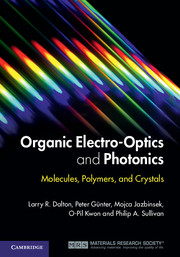Book contents
- Frontmatter
- Dedication
- Contents
- 1 Introduction
- 2 Nonlinear optical effects
- 3 Electro-optic effects
- 4 Molecular nonlinear optics
- 5 Acentric self-assembled films
- 6 Crystalline materials
- 7 Electrically poled organic materials and thermo-optic materials
- 8 Overview of applications
- 9 Organic electro-optic waveguides, switches, and modulators
- 10 Nonlinear optical infrared and terahertz frequency conversion
- 11 Photorefractive effect and materials
- 12 Conclusions and future prospects
- Index
- References
1 - Introduction
Published online by Cambridge University Press: 05 August 2015
- Frontmatter
- Dedication
- Contents
- 1 Introduction
- 2 Nonlinear optical effects
- 3 Electro-optic effects
- 4 Molecular nonlinear optics
- 5 Acentric self-assembled films
- 6 Crystalline materials
- 7 Electrically poled organic materials and thermo-optic materials
- 8 Overview of applications
- 9 Organic electro-optic waveguides, switches, and modulators
- 10 Nonlinear optical infrared and terahertz frequency conversion
- 11 Photorefractive effect and materials
- 12 Conclusions and future prospects
- Index
- References
Summary
Motivation
It has become increasingly recognized [1] that “photonic integration” is an important next step in the evolution of computing, telecommunications, sensing, transportation, medical, defense, and entertainment technologies. Such integration permits the best features of electronics and photonics to be exploited for information technology applications. There are important technological drivers of photonic/electronic integration, including realization of improved bandwidth and thermal management – transporting and manipulating information using photons avoids the high-frequency resistive losses and heating associated with movement of electrons in metal. Photonic/electronic integration is also evolving to include “chipscale” integration wherein both electronic and photonic circuitries are integrated on to the same chip, analogous to complementary metal-oxide semiconductor (CMOS) electronic integration, which has revolutionized computing. Potential advantages of chipscale integration include far-reaching improvements in size, weight, power consumption, performance, reliability, and cost. While chipscale photonic/electronic integration is not likely to be monolithic, as in CMOS electronic integration, and the problems to be faced will certainly be challenging, there can be little doubt that it will ultimately occur and will have considerable societal and economic impact. Such integration has been greatly advanced by recent developments in the field of silicon photonics, plasmonics, and metamaterial device architectures [2 to 21]. For example, the high index of refraction of silicon has permitted a striking reduction in the size of photonic circuits, making the dimensions of these circuits more compatible with chipscale integration. Further reductions in circuit dimensions appear possible by exploiting plasmonics.
A key component of photonic/electronic integration is the interconversion of signals between the electronic and photonic domains. This is where electro-optics comes into play. An electro-optic (EO) material is one in which the electrical fields associated with photons and electrons can communicate through a highly hyperpolarizable (easily perturbed by electric fields) charge distribution. For an electro-optic material to be optimum for the transduction of electronic signal information into photonic signal information, the charge distribution should be easily perturbed by small electric field potentials (ideally by millivolt electric field potentials to minimize power consumption) and should have very fast (ideally femtosecond) response to time-varying electrical fields. It is these features that have attracted attention to organic EO materials. The fundamental response time of conjugated π-electron systems is the phase relaxation time and is almost universally of the order of tens of femtoseconds.
- Type
- Chapter
- Information
- Organic Electro-Optics and PhotonicsMolecules, Polymers and Crystals, pp. 1 - 10Publisher: Cambridge University PressPrint publication year: 2015
References
- 2
- Cited by



